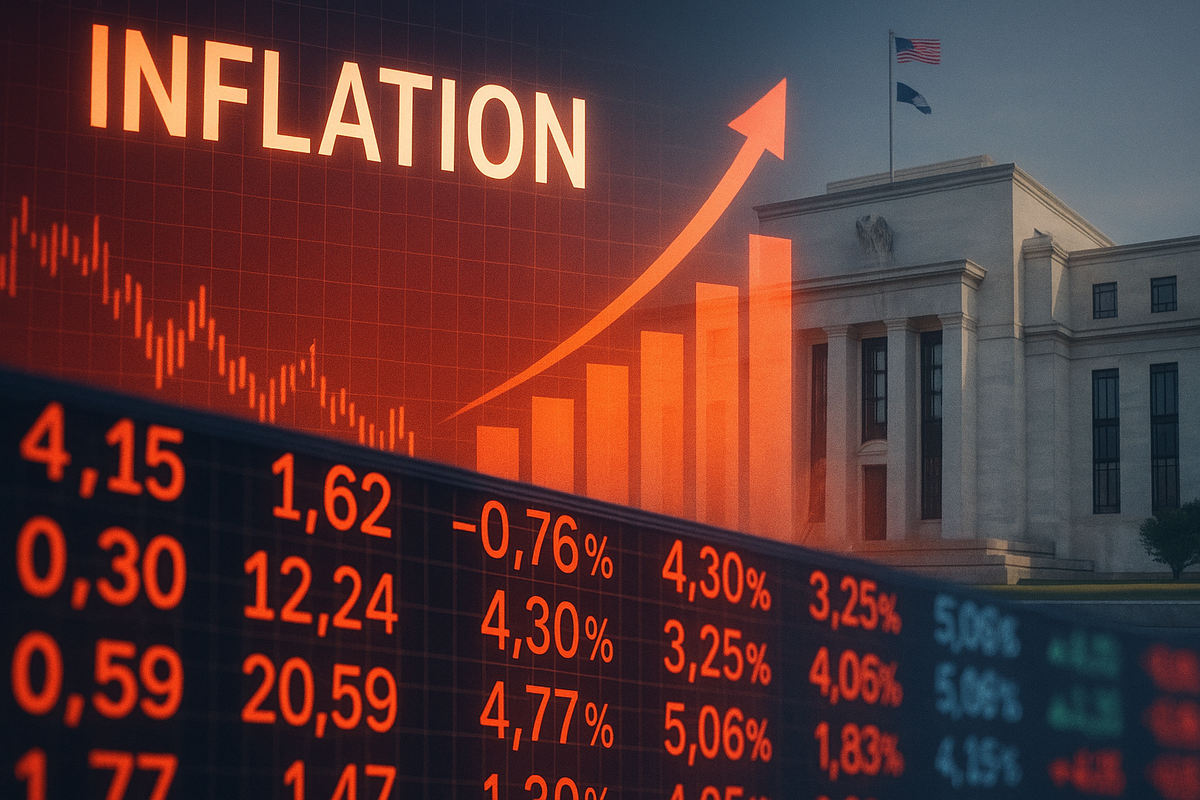
The financial markets are reeling from a hotter-than-expected July Producer Price Index (PPI) report, which has significantly dampened hopes for an interest rate cut by the Federal Reserve in September. A staggering 0.9% month-over-month jump in wholesale inflation, far exceeding economists' expectations, has sent shockwaves through the stock market, forcing traders to recalibrate their outlook on monetary policy. This "hot" inflation data directly contradicts earlier, more benign consumer price data and recent weak jobs reports, creating a complex dilemma for the Federal Reserve.
The unexpected surge in producer prices, marking the fastest monthly rise since May 2022 and the largest in over three years, has injected a fresh wave of uncertainty into the financial landscape. This development has led to a broad retreat in U.S. stocks, with major indices like the S&P 500 (NYSEARCA: SPY), Nasdaq Composite (NASDAQ: QQQ), and Dow Jones Industrial Average (NYSEARCA: DIA) experiencing slight declines or remaining largely flat, effectively cutting short recent rallies that had pushed markets to record highs.
What Happened and Why It Matters
The July PPI report revealed a significant and unexpected acceleration in wholesale inflation, with a 0.9% month-over-month increase. This figure dramatically surpassed the consensus estimate of a modest 0.2% rise, catching many market participants off guard. The core PPI, which excludes volatile food and energy prices, also saw a substantial increase, reinforcing concerns about underlying inflationary pressures.
This surge in producer prices is particularly concerning because it suggests that inflationary pressures are not abating as quickly as previously hoped. While the Consumer Price Index (CPI) report earlier in the week offered some optimism with a slightly cooler reading, the PPI data indicates that businesses are facing higher input costs. These rising costs could eventually be passed on to consumers, reigniting broader inflationary trends and complicating the Federal Reserve's efforts to bring inflation back to its 2% target.
The timeline of events leading up to this moment has been characterized by a delicate dance between inflation data, employment figures, and market expectations. For weeks, a series of weaker jobs reports and a seemingly moderating CPI had fueled optimism that the Federal Reserve would be in a position to begin cutting interest rates as early as September. Traders had priced in a near 100% chance of a September rate cut prior to the PPI release. However, the latest PPI data has abruptly shifted this sentiment, forcing a significant recalibration of these expectations.
Key players and stakeholders involved in this unfolding scenario include the Federal Reserve, whose monetary policy decisions are directly influenced by such economic indicators; businesses, which are grappling with rising input costs and the potential need to adjust pricing; and investors, who are now navigating a more uncertain interest rate environment. The initial market reaction has been one of caution and modest declines, with bond yields rising as investors demand higher compensation for inflation risk. This suggests a renewed focus on the "higher for longer" interest rate narrative, pushing back the anticipated timeline for rate cuts.
Winners and Losers in a "Higher for Longer" Environment
The hotter-than-expected PPI report and the subsequent recalibration of interest rate expectations will undoubtedly create a distinct set of winners and losers across various sectors of the market.
Companies with high debt levels are particularly vulnerable in a rising interest rate environment. As the cost of borrowing increases, these companies will face higher interest payments, which can erode their profit margins and hinder their ability to invest in growth. Sectors such as real estate, which are heavily reliant on financing, could also feel a significant pinch from higher interest rates, potentially leading to a slowdown in development and sales. Similarly, highly leveraged growth companies that depend on cheap capital for expansion may find their valuations pressured as investors demand higher returns to compensate for increased risk.
On the other hand, certain sectors and companies may find themselves in a more advantageous position. Financial institutions, particularly banks, often benefit from higher interest rates as their net interest margins expand. This means they can earn more on loans while the cost of deposits may not rise as quickly. Companies with strong balance sheets, low debt, and robust cash flows will also be better positioned to weather a period of higher interest rates, as they are less reliant on external financing and can continue to invest in their operations without significant financial strain. Furthermore, companies that can effectively pass on rising input costs to consumers without significantly impacting demand may also emerge as relative winners, though this strategy carries its own risks in a competitive market.
The broader impact on corporate margins is a key concern. If businesses continue to absorb these rising wholesale costs without passing them on, it could pressure S&P 500 profit margins. However, the rise in trade services inflation within the PPI report suggests that some of these costs are indeed starting to be passed along to consumers, which could lead to higher consumer prices down the line. This delicate balance between absorbing costs and passing them on will be a critical factor in determining the profitability of various companies in the coming months.
Industry Impact and Broader Implications
The July PPI report's implications extend far beyond immediate market reactions, fitting into broader industry trends and potentially triggering ripple effects across various sectors. This unexpected surge in wholesale inflation challenges the prevailing narrative of disinflation and could force a re-evaluation of economic forecasts.
One significant broader trend is the ongoing battle against inflation. While the Federal Reserve has been actively working to cool price pressures through monetary tightening, the PPI data suggests that the disinflationary trend might be more stubborn than previously thought. This could lead to a more hawkish stance from central bank officials, potentially prolonging the period of restrictive monetary policy. The report also highlights the complexities of global supply chains and geopolitical factors, such as tariffs, which can contribute to price increases at the producer level.
The potential ripple effects on competitors and partners are substantial. Industries that rely heavily on raw materials or intermediate goods, such as manufacturing and construction, will likely face increased cost pressures. This could lead to higher prices for their end products, potentially impacting consumer demand. Companies within these supply chains may also experience disruptions as they navigate higher input costs and potentially renegotiate contracts with suppliers. For instance, if a key component manufacturer faces significantly higher production costs, it could impact the pricing and availability of that component for all its downstream partners.
Regulatory and policy implications are also worth considering. If inflation proves to be more persistent, there could be increased pressure on policymakers to explore additional measures beyond monetary policy to address price stability. This might include discussions around supply-side policies aimed at boosting production or addressing bottlenecks. Historically, periods of elevated inflation have often led to increased scrutiny of pricing practices and potential calls for government intervention.
Comparing this event to historical precedents, the current situation bears some resemblance to periods where supply-side shocks or strong demand led to sustained inflationary pressures. However, the unique confluence of post-pandemic supply chain reconfigurations, geopolitical tensions, and a tight labor market makes this inflationary cycle distinct. The Federal Reserve's response will be closely watched, as its ability to navigate these complex dynamics will determine the ultimate trajectory of the economy. The "wait-and-see" approach that the Fed has adopted is now reinforced by this data, giving them more leeway to observe further economic indicators before making any definitive moves on interest rates.
What Comes Next
The hotter-than-expected July PPI report has undeniably shifted the landscape for monetary policy, and the coming months will be crucial in determining the short-term and long-term possibilities for the economy and financial markets.
In the short term, market participants will be keenly focused on upcoming economic data releases, particularly the next Consumer Price Index (CPI) report and further employment figures. These reports will provide additional clues about the trajectory of inflation and the health of the labor market, which will heavily influence the Federal Reserve's decision-making process. Any signs of continued inflationary pressures could further solidify the "higher for longer" interest rate narrative, potentially pushing back the timeline for rate cuts even further into 2026. Conversely, a significant cooling in subsequent inflation data could reignite hopes for a rate cut, though the bar for such a move has now been raised.
Potential strategic pivots or adaptations will be required across various sectors. Businesses will need to carefully manage their cost structures and pricing strategies in an environment of elevated input costs. Companies with strong pricing power and efficient supply chains will be better positioned to navigate these challenges. Investors, too, will need to adapt their portfolios, potentially favoring companies with robust balance sheets and those that are less sensitive to interest rate fluctuations. The focus may shift from high-growth, speculative assets to more value-oriented or defensive stocks.
Market opportunities or challenges that may emerge include a potential re-evaluation of sector performance. While technology stocks (NASDAQ: QQQ) have often been seen as beneficiaries of lower interest rates, a "higher for longer" scenario could lead to a rotation into more traditional, cyclical sectors that tend to perform better in an inflationary environment. Challenges will include increased volatility and the potential for further market corrections if inflation proves more persistent than anticipated. The bond market will also remain a critical area to watch, as yields will continue to react to inflation data and Federal Reserve commentary.
Potential scenarios and outcomes range from a continued period of elevated interest rates and slower economic growth if inflation remains stubbornly high, to a more gradual disinflationary process that eventually allows the Federal Reserve to ease monetary policy. The most optimistic scenario would involve a swift and sustained decline in inflation without a significant economic downturn, leading to a "soft landing." However, the latest PPI data suggests that achieving this soft landing may be more challenging than previously thought, increasing the likelihood of a more prolonged period of economic uncertainty.
Conclusion
The July Producer Price Index report serves as a stark reminder that the battle against inflation is far from over. The hotter-than-expected 0.9% jump in wholesale inflation has significantly dampened hopes for a September interest rate cut by the Federal Reserve, forcing a recalibration of market expectations and introducing a fresh wave of uncertainty.
The key takeaway from this event is the persistence of inflationary pressures at the producer level, which could eventually translate into higher consumer prices. This complicates the Federal Reserve's dual mandate of maintaining price stability and promoting full employment, potentially leading to a more prolonged period of restrictive monetary policy. Investors should prepare for a "higher for longer" interest rate environment, which will have implications for corporate profitability, sector performance, and overall market valuations.
Moving forward, investors should closely watch upcoming inflation data, particularly the Consumer Price Index, as well as employment figures. These reports will be crucial in shaping the Federal Reserve's next moves. Companies with strong balance sheets, pricing power, and efficient operations will be better positioned to navigate the challenges posed by elevated input costs. The market will likely remain sensitive to any signs of persistent inflation, and volatility could remain elevated. The ultimate significance and lasting impact of this PPI report will depend on whether this surge in wholesale inflation is a temporary blip or a harbinger of more entrenched price pressures, dictating the pace and direction of monetary policy for the foreseeable future.





